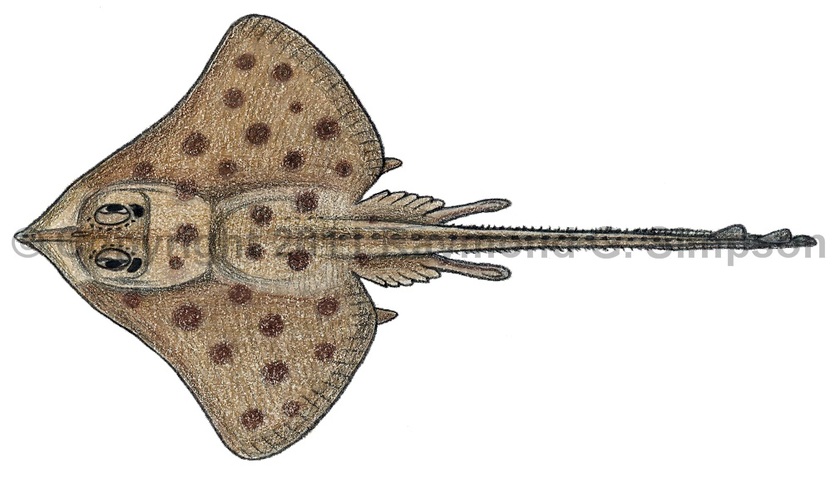
Common Name
Cuban Legskate
Year Described
Bigelow & Schroeder, 1948
Identification
Disk rhomboidal with a slightly concave anterior margin of snout and pectoral fin. Snout moderately long (>14% TL) with stiff rostral cartilage. Pectoral fins with rounded tips. Anterior pelvic fin lobe separated from posterior lobe and greatly elongated; about as long as the squared-off posterior lobe. Tail is long and thin. Posterior part of tail with skin folds that broaden toward tip. There are two dorsal fins placed far back on tail with distance between them half the width of the first dorsal fin. Caudal fin is barely evident and tapers to a round tip. Eyes and mouth large. Jaws with 44-50 tooth rows. Male claspers thin and short.
Body is mostly smooth with rows of denticles restricted to bands along back. The rostrum has 5-10 thorns. There are 4-8 orbital thorns, and 2 nuchal thorns on the head. No scapular thorns. Posterior abdomen and tail with a single median row of 31-52 thorns (small thorn gap on anterior abdomen). Up to six parallel rows of thorns on sides of tail. There are 1-4 thorns present between the dorsal fins. Ventral surface without dermal denticles except for under tail.
Color
Dorsum uniformly brown with variably expressed round brown spots about the size of the orbit or smaller. Spots are more conspicuous in smaller specimens. Tail faintly banded. Fins are dark brown in adults. Ventrum pale brown with darker brown mottling on disk. Underside of tail whitish.
Size
Maximum size to 34cm TL.
Habitat
A fairly deepwater skate found on outer continental shelves and slopes (365-870m).
Range
Known from off Florida, the northern Caribbean off Cuba, and the southwestern Gulf of Mexico.
References
Last, P.R., White, W.T., Carvalho, M.R. de, Séret, B., Stehmann, M.F.W & Naylor, G.J.P (Eds.). 2016. Rays of the World. CSIRO Publishing, Melbourne.
Other Notes
This is the only Atlantic Cruriraja with a smooth dorsum and denticles restricted to median bands.